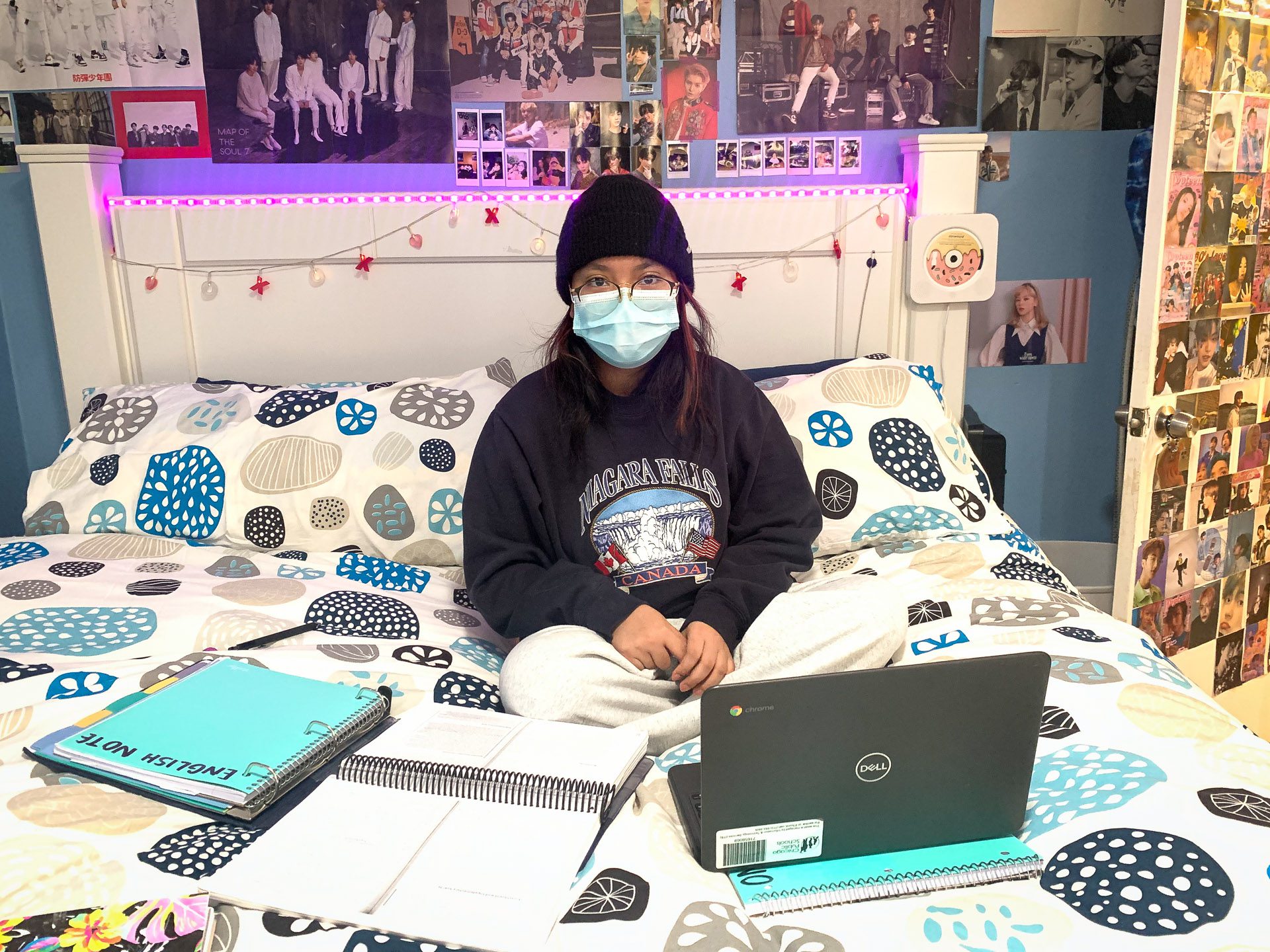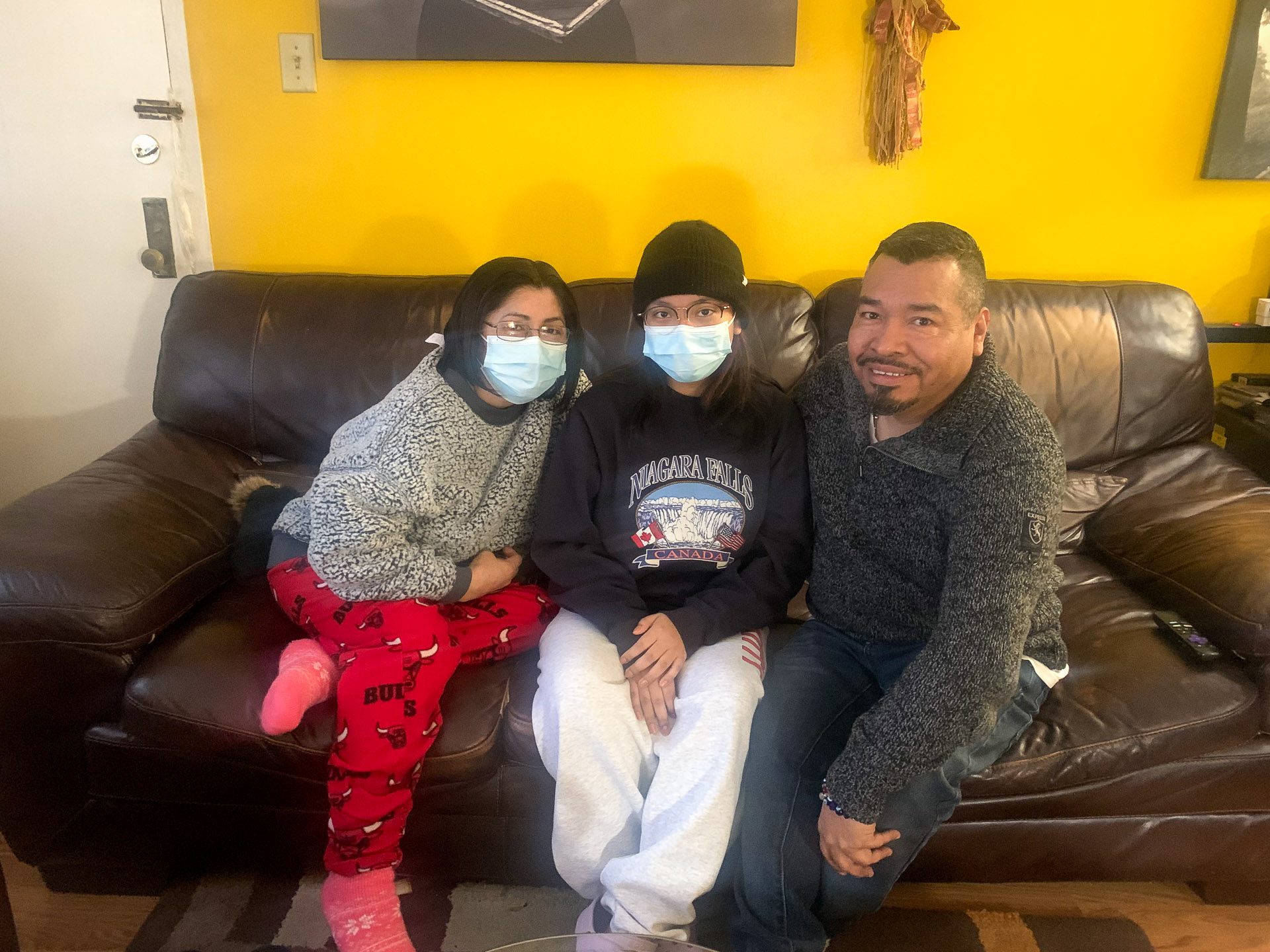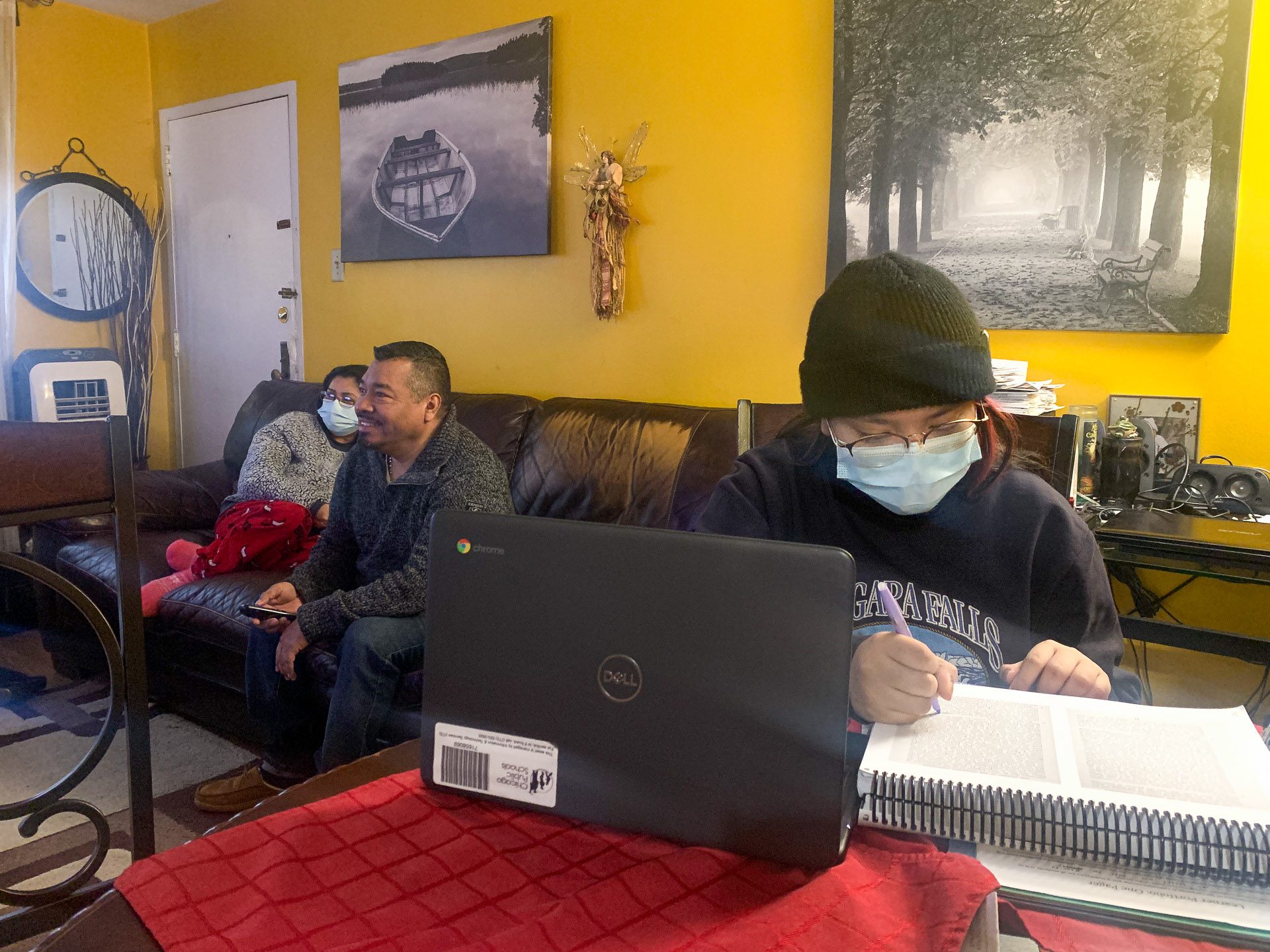 Fotografía de Leslie Hurtado/ Borderless Magazine
Fotografía de Leslie Hurtado/ Borderless MagazineAtrapados en el fuego cruzado entre el distrito escolar de Chicago y el sindicato de profesores, los estudiantes se preguntan quién protege su salud.
El pasado domingo por la mañana, Gisselle Baltazar, estudiante de tercer año del instituto Nicholas Senn, se levantó para hacer su cama, que normalmente se convierte en un escritorio para sus materiales durante la escuela virtual. Saludó a sus padres y comió algo ligero antes de ponerse a estudiar. Primero tuvo que repasar los apuntes de la clase de cine, una de sus asignaturas favoritas.
Pero a diferencia de la mayoría de las semanas, Baltazar no volvió a la escuela al día siguiente: Las Escuelas Públicas de Chicago cancelaron las clases el lunes, marcando el cuarto día consecutivo que más de 340.000 estudiantes han estado fuera de la escuela desde que CPS y el Sindicato de Maestros de Chicago han estado negociando sobre el regreso a la enseñanza presencial. Ambas partes llegaron finalmente a un acuerdo a última hora de la noche del lunes para reanudar las clases el miércoles.
"Me preocupa volver al colegio porque mis amigos dieron positivo la semana pasada", dice Baltazar. "Y a algunos de mis compañeros no les gusta ponerse la mascarilla. El aula no es segura ahora mismo".
Noticias que ponen el poder en el punto de mira y a las comunidades en el centro.
Suscríbase a nuestro boletín gratuito y reciba actualizaciones dos veces por semana.
La lucha de una semana entre el distrito y el sindicato de profesores por la seguridad del COVID ha sido una fuente de ansiedad para los alumnos del tercer distrito escolar más grande del país. Para muchas familias inmigrantes como la de Baltazar, para las que el inglés es una segunda lengua, la incertidumbre y la inestabilidad de los horarios diarios pueden resultar especialmente caóticas. Algunos estudiantes recibieron ordenadores portátiles o tabletas y libros de texto para llevar a casa antes del cierre de las escuelas. Pero muchos otros no recibieron nada de CPS antes del cierre.
Esto ha ampliado las disparidades a las que se enfrentan las familias en el diverso distrito escolar público de Chicago. Muchas familias inmigrantes no pueden permitirse recursos digitales, como tabletas y ordenadores. Incluso con recursos limitados proporcionados por la escuela, los padres hispanohablantes se enfrentan a retos adicionales para enseñar a sus hijos en casa debido a las barreras lingüísticas y dificultades para navegar por la tecnología. Según un informe anterior de Borderless Magazine, los alumnos bilingües también pueden requerir recursos adicionales para volver con éxito al aprendizaje presencial tras el cierre de la escuela o el aprendizaje virtual.
Casi 47% de los estudiantes de CPS se identifican como hispanos, y el 18,6% son estudiantes bilingües. Según datos del Departamento de Salud Pública de Illinois, alrededor de 15% de los hispanos de Illinois han dado positivo, mientras que alrededor de 11% de la población negra también han dado positivo. Al igual que con las otras variantes de coronavirus, la última oleada de Omicron ha afectado desproporcionadamente a los hispanos y negros de Illinois más que a los blancos.
Frente a estas estadísticas, los estudiantes con los que habló Borderless Magazine dijeron que prefieren el aprendizaje virtual porque es una opción más segura. "Viniendo de un estudiante, sería mejor para nosotros aprender en línea por el momento", dijo Baltazar. "Aunque el aprendizaje en persona puede ser difícil, sigo pensando que las clases en línea nos ayudarían por ahora. Dado que los casos [de COVID] son realmente altos, es bastante peligroso estar en un entorno en el que no sabes si alguien tiene COVID porque los padres están enviando a sus hijos [que dieron positivo] sin informar a las escuelas."

Los miembros de CTU han luchado repetidamente para enseñar temporalmente a distancia para mantener a los estudiantes y al personal a salvo del aumento de casos relacionados con Omicron. El acuerdo provisional entre el sindicato y CPS publicado anoche permite a las escuelas cambiar de la enseñanza presencial a la enseñanza a distancia si el 40% de los estudiantes están en cuarentena durante la oleada de COVID-19 o el 50% están en cuarentena después de que la oleada disminuya, según un informe de WBEZ. El acuerdo también permite a los comités de seguridad escolar votar el cierre de escuelas si es necesario durante la pandemia. Anteriormente, las escuelas individuales no disponían de un marco para cerrar o ponerse a distancia.
Los miembros del sindicato votarán el acuerdo propuesto a finales de esta semana. Sin embargo, el voto de la Cámara de Delegados del sindicato de anoche puso fin a su acción, por lo que los educadores han vuelto hoy al trabajo para planificar las clases del resto de la semana.
CPS y la Alcaldesa Lori Lightfoot sostienen que la escuela es el lugar más seguro para que los estudiantes estén durante la pandemia. "La investigación ha demostrado que los estudiantes que aprenden en persona y el personal que enseña en persona eran menos propensos a contraer COVID que la comunidad en general", dijo CPS en un comunicado de prensa. El alcalde caracterizó previamente la negativa del sindicato a enseñar en persona como un "paro laboral ilegal".
Los padres de Gisselle, María y Samuel Baltazar, subrayaron la necesidad de que los miembros de la CTU y los funcionarios de CPS trabajen juntos para crear un plan de seguridad que ayude a frenar la propagación de los casos de COVID-19 en las escuelas.
"Prefiero el aprendizaje a distancia durante este tiempo", dijo Samuel Baltazar en español. "Quiero que los maestros y CPS se unan para mantener a los estudiantes a salvo del virus. [La alcaldesa] Lori Lightfoot y [el CEO de CPS] Pedro Martínez quieren que los niños regresen a la escuela, pero ¿cómo funcionaría eso si tu hijo pudiera enfermarse de otros estudiantes que probablemente contrajeron el virus?"
Según datos del distrito de CPS, más de 3,081 personal de CPS han dado positivo, mientras que 6,034 alumnos han notificado casos positivos. Gisselle dijo que uno de sus profesores dio positivo por COVID la semana pasada. Mientras que su educadora recibió instrucciones de dar clase a distancia en casa, sus compañeros debían ir a clase ese mismo día.
"A otra profesora mía también le dieron COVID la semana pasada, y no estaba en clase", añadió. "Tampoco dio clase virtualmente. A mi amiga le dieron COVID después de las vacaciones".

William Molina, un estudiante de tercer año que también asiste a la escuela secundaria Nicholas Senn, dijo que su familia tiene antecedentes de diabetes. Dijo que debido a esto, tiene miedo de volver a clase el miércoles.
"Creo que mi madre es más propensa a infectarse por el virus", afirma. "Volver a clase pondría a mi madre en peligro, y eso me asustaría. Así que esa es la razón por la que me puse la vacuna de refuerzo: para mantener a salvo a mi familia."
La educadora de CPS Amelia Suárez, miembro del sindicato que enseña a alumnos de octavo grado en una escuela primaria de South Side, dijo que la tasa de positividad es desalentadora. Después de quedarse en casa para enseñar remotamente el miércoles pasado, miles de educadores de CPS fueron bloqueados de sus cuentas y no pudieron comunicarse con estudiantes y padres sobre su decisión.
"Uno de mis colegas pudo encontrar [las cuentas personales de los estudiantes] el miércoles, y mientras [enviaba correos electrónicos a los estudiantes], descubrimos que la mayoría de ellos dieron positivo", dijo. "Es simplemente asqueroso y repugnante oír que mi salud o la de mis alumnos no es lo bastante importante como para informar a distancia".
El acuerdo del lunes no incluye muchas protecciones que los miembros del CTU han querido, incluyendo una métrica para mover todo el distrito escolar a la enseñanza a distancia, según WBEZ. El acuerdo incluye pruebas diarias, máscaras PPE ampliadas y el aumento del número de profesores sustitutos.
Como se espera que los estudiantes regresen a las aulas el miércoles, Sofía Fátima, estudiante de último año en la Escuela Secundaria Amundsen, dijo que espera que el sindicato y CPS puedan llegar a un acuerdo más amistoso en futuras negociaciones, por el bien de los estudiantes y las familias.
"Espero que CTU y CPS ahora sean un poco más transparentes sobre cómo se están manejando las negociaciones porque cada vez que estas [negociaciones] suceden, ambas partes siempre están tratando de villanizar a la otra", dijo. "Quiero ver más entrevistas y conferencias de prensa en las que ambas partes estén en la misma sala y puedan responsabilizarse mutuamente".

